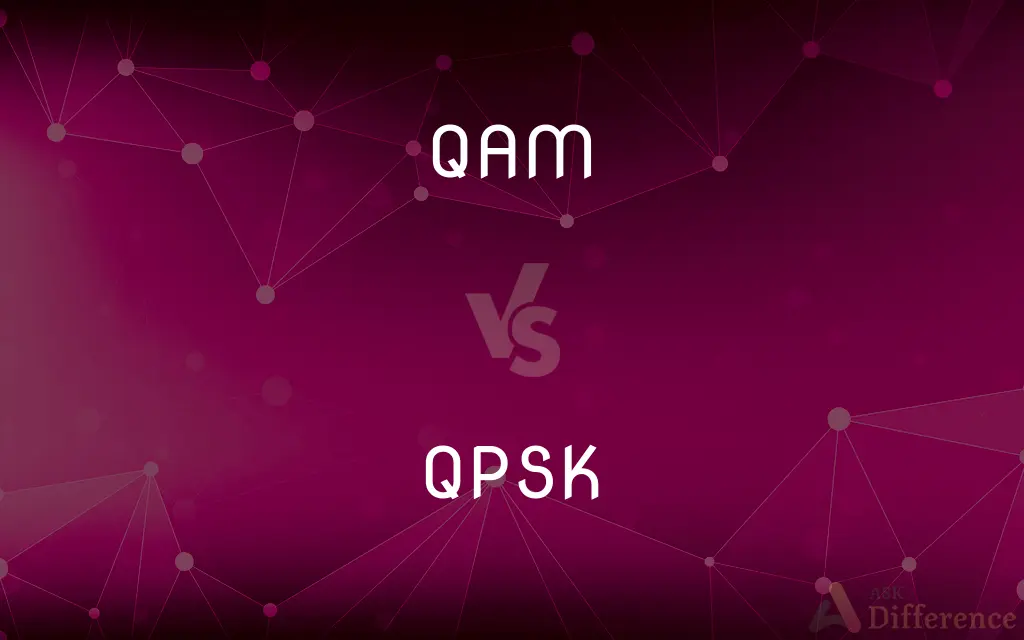QAM vs. QPSK — What's the Difference?
Edited by Tayyaba Rehman — By Fiza Rafique — Published on January 15, 2024
QAM is a modulation scheme using amplitude and phase variations, whereas QPSK is a phase modulation technique using four distinct phase angles.

Difference Between QAM and QPSK
Table of Contents
ADVERTISEMENT
Key Differences
QAM, or Quadrature Amplitude Modulation, combines amplitude and phase modulation to convey data, allowing for more information to be transmitted over a given bandwidth compared to QPSK. QPSK, or Quadrature Phase Shift Keying, uses four points on the constellation diagram, each representing a two-bit combination. It is a special case of QAM where the amplitude is kept constant.
In QAM, both amplitude and phase changes result in a denser constellation diagram, increasing the bits per symbol but also making it more susceptible to noise. QPSK’s constant amplitude makes it more robust to amplitude variations and noise than higher-order QAM schemes. QAM can be scaled to higher orders like 16-QAM, 64-QAM, etc., packing more bits per symbol, while QPSK is fixed at 4 distinct states.
While QAM achieves higher data rates due to its denser constellation, it requires a higher signal-to-noise ratio (SNR) for the same error performance as QPSK. QPSK is more efficient in terms of power usage since it doesn’t vary the signal amplitude, which is an advantage in satellite and space communications where power is limited.
The adaptability of QAM allows it to be used in various bandwidth and SNR scenarios, making it suitable for adaptive modulation schemes. Conversely, QPSK's simplicity gives it an edge in terms of implementation cost and complexity, being a preferred choice in simpler or more cost-sensitive applications.
QAM's complexity increases with higher-order schemes, requiring more precise calibration and error correction mechanisms. QPSK’s simpler modulation does not need such stringent requirements, making it less complex to implement in communication systems.
ADVERTISEMENT
Comparison Chart
Constellation Points
Variable, can be very high (e.g., 256-QAM)
Fixed at 4 points
Modulation Components
Amplitude and Phase
Phase only
Data Rate
Higher, with more bits per symbol
Lower, fixed at 2 bits per symbol
Power Efficiency
Less power efficient at higher orders
More power efficient
Robustness to Noise
Lower at higher orders
Higher, due to constant amplitude
Complexity
Higher, especially at higher orders
Lower, easier to implement
Usage Scenarios
Cable modems, digital TV
Satellite communications, GPS
Compare with Definitions
QAM
QAM enables higher data throughput in digital broadcasting.
Our digital TV signal is encoded with 64-QAM.
QPSK
QPSK is a form of Quadrature Amplitude Modulation with constant amplitude.
In QPSK, the transmitter conserves power by not varying the signal amplitude.
QAM
QAM is a signal modulation technique that uses both amplitude and phase variations.
The cable modem uses 256-QAM to provide high-speed Internet access.
QPSK
QPSK's simpler design makes it ideal for cost-sensitive applications.
The design simplicity of QPSK reduces the cost of our communication system.
QAM
QAM's performance is highly dependent on the signal-to-noise ratio.
We're upgrading our receivers to improve QAM performance in noisy environments.
QPSK
QPSK is known for its robustness against interference and noise.
Due to its resilience, QPSK is preferred in noisy channel conditions.
QAM
QAM can be adapted to different quality levels by changing the constellation size.
Adaptive QAM can dynamically adjust to the varying channel conditions.
QPSK
QPSK is a phase modulation technique that transmits two bits per symbol.
QPSK is chosen for its spectral efficiency in our satellite transmission.
QAM
QAM is used in wireless communication to transmit multiple bits per symbol.
To achieve faster data rates, our network implements QAM.
QPSK
QPSK uses four distinct phase angles to represent digital data.
The GPS signal employs QPSK for reliable earth-to-satellite communication.
Common Curiosities
What is an advantage of QPSK over QAM?
QPSK is more robust to noise due to its constant amplitude.
Are QAM and QPSK compatible with each other?
They are not directly compatible as they are different modulation schemes.
What does QAM stand for?
QAM stands for Quadrature Amplitude Modulation.
Can QAM transmit more data than QPSK?
Yes, QAM can transmit more data than QPSK by using different amplitude levels.
How does QAM affect bandwidth usage?
QAM allows for more efficient bandwidth usage by transmitting more bits per symbol.
Is QPSK used in WiFi?
Yes, QPSK is used in WiFi as part of more complex modulation schemes.
What is the primary use of QAM?
QAM is primarily used for cable television and modem applications.
What does QPSK stand for?
QPSK stands for Quadrature Phase Shift Keying.
Which is more complex to implement, QAM or QPSK?
QAM is generally more complex to implement, especially at higher orders.
Why is QAM preferred in cable modems?
QAM is preferred in cable modems for its ability to carry higher data rates.
Can QPSK work better in low signal-to-noise ratio conditions?
Yes, QPSK can maintain better performance in lower signal-to-noise ratio conditions.
How does weather affect QAM and QPSK signals?
Weather can affect QAM more due to its amplitude variations, whereas QPSK is less sensitive.
Are there different types of QAM?
Yes, there are different types of QAM, such as 16-QAM, 64-QAM, and 256-QAM, with varying levels of complexity.
Does QPSK have a higher error rate than QAM?
QPSK generally has a lower error rate at the same energy levels due to its constant amplitude.
What type of modulation is QPSK considered?
QPSK is considered a phase modulation technique.
Share Your Discovery

Previous Comparison
Annually vs. Per Year
Next Comparison
Goth vs. AltAuthor Spotlight
Written by
Fiza RafiqueFiza Rafique is a skilled content writer at AskDifference.com, where she meticulously refines and enhances written pieces. Drawing from her vast editorial expertise, Fiza ensures clarity, accuracy, and precision in every article. Passionate about language, she continually seeks to elevate the quality of content for readers worldwide.
Edited by
Tayyaba RehmanTayyaba Rehman is a distinguished writer, currently serving as a primary contributor to askdifference.com. As a researcher in semantics and etymology, Tayyaba's passion for the complexity of languages and their distinctions has found a perfect home on the platform. Tayyaba delves into the intricacies of language, distinguishing between commonly confused words and phrases, thereby providing clarity for readers worldwide.














































